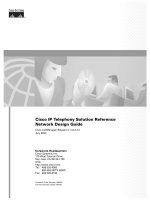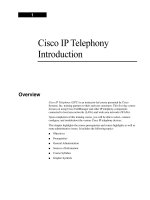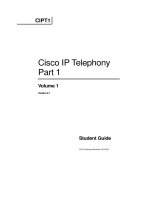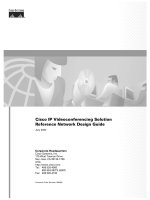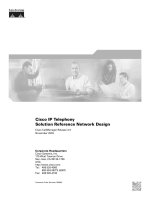Tài liệu Cisco IP Telephony- Enterprise Voice Over Data Design Test ppt
Bạn đang xem bản rút gọn của tài liệu. Xem và tải ngay bản đầy đủ của tài liệu tại đây (322.81 KB, 11 trang )
Cisco Design Essentials: Cisco IP Telephony
-
Enterprise Voice Ove
r Data Design Test
1)
CallManager 3.0 will support transcoding. This allows call legs with different encodings (for example, G.711 and
G.729a) instead of the current requirement that a call have the same encoding fr
om end to end.
a. True
b. False
2)
For LFI, when using FRF.12 the fragments are reassembled at the other end of the circuit; however, if
fragmented on an IP interface w
ith maximum transmission unit (MTU) reduction, the fragments remain for the life of
the packet.
a. True
b. False
3)
For IP Telephony the recommended admissions control tool is:
a. RSVP
b. Manual intervention using access lists
c. Appropriate network deployment following known success guidelines
4
) Nortel uses "nB+D" to refer to:
a. Their ISDN support, that is, both BRI and PRI
b. Use of a single D channel to support multiple voice channels
c. A marketing slogan "no Better Data" for their data products
d. Another name for Nortel ISL
5)
The only standards-based signaling between a PBX and voicemail is _____.
a. Simplified Messaging Desk Interface (SMDI)
b. TAPI
c. Analog Messaging Indication System (AMIS)
d. SGCP
6)
When an IP Phone makes a call through a CallManager to a Cisco IOS gateway on a Cisco router, the phone
talks Cisco Skinny protocol to the CallManager, but the CallManager talks ________ to the Cisco IOS gateway.
a. Simple Gateway Control Protocol (SGCP)
b. Multimedia Gateway Control Protocol (MGCP)
c. H.323
d. SIP
7)
Cisco's uOne is a standards-
based messaging application that manages message playback, message delivery, and
the message creation process in CallManager 2.4 deployments.
a. True
b. False
8)
CallManager 2.x puts call detail records (CDRs) in Access or an OBDC database that is readable by most billing
packages, but does not provide direct billing itself.
a. True
b. False
9)
Which of the following is a variable source of delay in voice networks:
a. Queuing delay
b. Propagation delay
c. Serialization delay
d. Coder processing delay
10)
The ITU specifies the threshold for high quality voice as an end-to-end delay of:
a. 100 ms
b. 150 ms
c. 200 ms
d. 250 ms
11)
Which of the following statements are true if a legacy voicemail system does NOT have a SMDI interface?
a. AVVID users cannot get to the legacy voice mail system
b. AVVID users can get to the legacy voice mail but do not get an MWI
c. Both A and B
d. Neither A nor B
12)
With redundant centralized CallManagers, failover takes about _____.
a. 30 seconds
b. 90 seconds
c. 3 minutes
d. 10 minutes
13)
Applications using this ATM service category should be tolerant of higher delays and delay variations.
a. Constant bit rate (CBR)
b. Real-time variable bit rate (VBR-RT)
c. Non-real-time VBR (VBR-NRT)
d. Available bit rate (ABR)
14)
Which of the following statements is not a characteristic of FRF.11?
a. It provides application support for compressed voice
b. It provides multiplexing of up to 255 subchannels
c. It allows multiple payloads
d. It uses a predictable fixed length payload
15)
To support a conference of three or more H.323 terminals, a ______ is required.
a. Multipoint control unit (MCU)
b. Gatekeeper
c. Gateway
16)
What happens to an attempted call that exceeds the bandwidth limit for admission control in CallManager 2.4
when maximum IP WAN bandwidth is limited per location in kbps?
a. You get a busy signal and then the call will automatically roll to the PSTN fallback
b. You get a busy signal and you must hang up and dial a unique local PSTN access code
c. Your call goes out on the PSTN transparently
17)
If you install the conferencing software on a separate NT server, the maximum number of participants on a
conference call is _____.
a. 18
b. 20
c. 33
d. 49
18)
Which transport technique is preferred to carry Lucent's CMS?
a. Digital cross connect
b. Frame forwarding
c. D-channel ATM CES
d. STUN
19)
System assurance is a key part of the planning stage of design methodology, because:
a. It ensures that a network foundation exists on which voice applications can be built
b. It ensures that an existing network can handle voice traffic reliably
c. It provides the necessary information to perform capacity planning
d. A, B, and C
e. A and B
f. B and C
g. A and C
20)
Cisco-switched VoFR protocol includes forwarding of the called telephone number and supports tandem
switching of the call over multiple Frame Relay permanent virtual circuit (PVC) hops.
a. True
b. False
21)
You are planning for an IP Telephony deployment including the deployment of CallManager in a branch office.
Which of these factors should you consider as you assess the customer's existing branch office voice and data
netw
orks?
a. Are firewalls present on any LAN where Voice over IP traffic would travel?
b. Are the available ports switched or on hubs?
c. Does the customer require an MWI for voice mail messages?
d. What protocol or signaling is used between handset and PBX for the existing PBX?
e. A, B, C, and D
f. A and B
g. A, B and C
h. A and C
22)
Which of the following statements are true about echo cancellation?
a. Echo is due to the way handsets are wired
b. Echo cancellation at your end prevents echo being heard at the far end
c. The echo canceler runs in Cisco IOS
d. A, B, and C
e. A and B
f. B and C
g. A and C
23)
Cisco implements signaling between the call agent and a terminal using SGCP.
a. True
b. False
24)
Using a single PVC for voice and data, instead of separate PVCs for each:
a. Is more economical
b. Provides higher quality voice
c. Requires a star topology
d. A, B, and C
e. A and B
f. B and C
g. A and C
25)
The mechanism used to prevent selected phone extensions from calling long distance is:
a. Class of service (CoS)
b. Coordinated dialing Plan (CDP)
c. Automatic Route Selection (ARS)
d. Basic Route Selection (BARS)
26)
The _____________ low bit-rate coder requires less CPU power, while maintaining high voice quality, thus
enabling support for two voice calls on a single DSP.
a. G.711
b. G.729
c. G.729a
d. G.723
27)
Which of the following are you least likely to encounter providing PBX trunk signaling?
a. ISDN PRI D channel
b. DASS#2
c. FXS loop start
d. a proprietary PBX-to-PBX protocol such as Lucent's DCS+
28)
If the maximum acceptable delay that a low-speed link may add to your delay budget is 20 ms and the link
speed is 64 kbps, then the maximum fragment size should be ____ bytes.
a. 80
b. 140
c. 160
d. 320
29)
Consider this scenario. You have two branch offices using IP telephony with CallManager 2.4. To handle
admissions control betw
een the two offices over a WAN, which of the following solutions will work?
• Solution A: Use a central CallManager (perhaps redundant CallManagers) with each office being a separate
region. Intra-region calls can be G.711, but inter-region calls can be G.7
29 (unless to voice mail). Limit WAN
bandwidth at each egress point and block calls that will exceed that level.
• Solution B: Put a CallManager in each location and network them together using H.323 (running on a Cisco
IOS gatekeeper). You can then use the
zone bandwidth feature to limit the number of calls and force overflow
to the Public Switched Telephone Network (PSTN).
a. Solution A
b. Solution B
c. Either A or B
d. Neither A nor B
30)
In ATM the AAL Cell Tax refers to the fact that the number of bytes in the AAL varies from 0 to 5 bytes and
that these bytes are subtracted from the si
ze of the remaining 48 bytes available for payload (since the header size is
constant), thus reducing payload maximum to as low as 44 bytes.
a. True
b. False
31)
This IP Telephony component plays dial tone.
a. CallManager
b. MTP
c. uOne
d. IP Phone
e. Gateway
32)
Which of the following are true statements about CCS?
a. CCS is not necessarily ISDN
b. Instead of robbed-bit signaling, a DS0 is reserved for signaling
c. Signaling is handled on TS 16 for E1
d. A, B, and C
e. A and B
f. B and C
g. A and C
33)
Leaving or retrieving a message under the uOne architecture involves which of the following protocols:
a. SMTP
b. Lightweight Directory Access Protocol (LDAP)
c. Cisco Skinny
d. All the above
e. None of the above
34)
For capacity planning purposes, plan for G.711 traffic to require ___ through a Cisco router (uncompressed
RTP header and excluding link
-layer header).
a. 80 kbps
b. 24 kbps
c. 17 kbps
d. 74.6 kbps
35)
Which of the following elements requires minimizing to provide voice quality in packet or cell networks?
a. Loss
b. Delay/Delay Variation
c. Echo
d. A, B, and C
e. A and B
f. B and C
g. A and C
36)
Real-time Transport Protocol (RTP) is an industry standard for transporting:
a. Voice over IP
b. Voice over Frame Relay
c. Voice over ATM
d. A, B, and C
e. A and B
f. B and C
g. A and C
37)
Calculate the bandwidth for a G.729 call using a 20-ms sample size with AAL5 configured.
a. 20 kbps per call
b. 21.2 kbps per call
c. 28 kbps per call
d. 53 kbps per call
e. None of the above
38)
Bandwidth calculations assume one party speaks at a time; therefore, if both speak at the same time, the
bandwidth requirement doubles.
a. True
b. False
39)
Which of the following is a proprietary Nortel PBX protocol?
a. DCS
b. DPNSS
c. MCDN
d. CORNET
40)
This prioritization tool can support up to 64 classes to classify traffic for queuing.
a. IP Precedence
b. DiffServ
c. Resource Reservation Protocol (RSVP)
d. Class-based weighted fair queuing (CBWFQ)
41)
In designs involving tie-line replacement and toll bypass solutions, voice mail considerations will not impact
your design since voice mail will typica
lly be carried via the PSTN to the PBX.
a. True
b. False
42)
This IP Telephony component is required for supplementary services between Cisco IP Phone and H.323
devices
.
a. CallManager
b. MTP
c. uOne
d. IP Phone
e. Gateway
43)
Which of the following statements is true for an H.323 Gateway?
a. Handles call setup and clearing on both sides
b. Can translate between transmission formats for an IP network and the PSTN
c. Is optional in H.323 networks
d. All of the above
e. None of the above
44)
With CallManager 2.x, a distributed CallManager design requires the use of an MTP with each CallManager.
You are then required to use which CODEC?
a. G.723
b. G.729a or G.729b
c. G.711
d. G.728
45)
Which of the following statements are true about Voice over Frame Relay services?
a. Primary payload types may include voice, fax, or data
b. Signaled payload types may include dialed digits, silence information, or CAS ABCD bits
c. Management payload types include faults and performance measurements
d. A and B
e. B and C
f. A and C
g. A, B and C
46)
All of the following are categories of dial plan migration issues to consider except:
a. Scalability
b. Compatibility
c. Functionality
d. Security
e. PBX architecture
47)
Which of the following is a limitation with MTPs in
CallManager 2.x?
a. Limited to G.711 over the LAN
b. Currently there is no scheduling software
c. Inability to reserve ports for conferencing
d. All of the above
e. None of the above
48)
CallManager 3.0 will support MGCP, which allows for Cisco IOS gateway and CallManager integration
without an MTP.
a. True
b. False
49)
_______________ provide a "clear channel" where the entire payload can be filled with one voice channel, or a
continuous stream of bytes can be placed into cells.
a. T1/E1 unstructured services
b. T1/E1 structured services
50)
Frame Relay and ATM interworking are provided through:
a. FRF.5
b. FRF.8
c. FRF.12
d. A, B, and C
e. A and B
f. B and C
g. A and C
Grade
